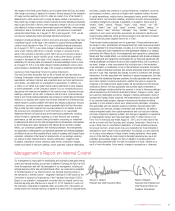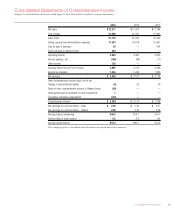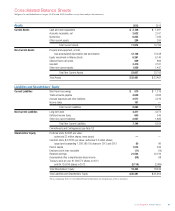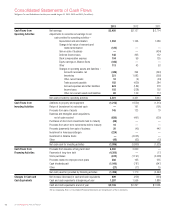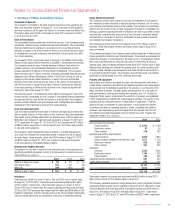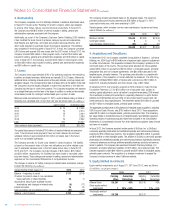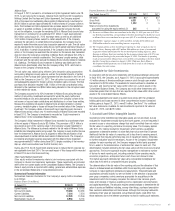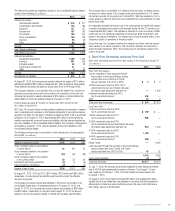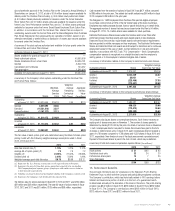Walgreens 2013 Annual Report Download - page 37
Download and view the complete annual report
Please find page 37 of the 2013 Walgreens annual report below. You can navigate through the pages in the report by either clicking on the pages listed below, or by using the keyword search tool below to find specific information within the annual report.Warrants
The Company and Alliance Boots were each issued (a) a warrant to purchase up to
11,348,456 shares of AmerisourceBergen common stock at an exercise price of
$51.50 per share exercisable during a six-month period beginning in March 2016,
and (b) a warrant to purchase up to 11,348,456 shares of AmerisourceBergen common
stock at an exercise price of $52.50 per share exercisable during a six-month period
beginning in March 2017. The Company’s warrants are valued at the date of issuance
and the end of the period using a Monte Carlo simulation. Key assumptions used
throughout the valuation include risk-free interest rates using constant maturity
treasury rates; the dividend yield for AmerisourceBergen’s common stock;
AmerisourceBergen’s common stock price at valuation date; AmerisourceBergen’s
equity volatility; the number of shares of AmerisourceBergen’s common stock
outstanding; the number of AmerisourceBergen employee stock options and the
exercise price; and the details specific to the warrants. The fair value of the Company’s
warrants on March 18, 2013, the date of issuance, was $77 million. The Company
recorded the fair value of its warrants as a non-current asset with a corresponding
deferred credit in its Consolidated Balance Sheets. The deferred credit attributable to
the warrants will be amortized over the life of the warrants. As of August 31, 2013,
the fair value of the Company’s warrants was $188 million, which resulted in the
Company recording other income of $111 million for fiscal 2013 within its Consolidated
Statements of Comprehensive Income. The increase in the fair value of the warrants
was primarily attributable to the increase in the price of AmerisourceBergen’s
common stock. In addition, the Company recorded $9 million of other income
relating to the amortization of the deferred credit in fiscal 2013.
Pre-Opening Expenses
Non-capital expenditures incurred prior to the opening of a new or remodeled store
are expensed as incurred.
Stock-Based Compensation Plans
In accordance with ASC Topic 718, Compensation – Stock Compensation, the Company
recognizes compensation expense on a straight-line basis over the employee’s vesting
period or to the employee’s retirement eligible date, if earlier.
Total stock-based compensation expense for fiscal 2013, 2012 and 2011
was $104 million, $99 million and $135 million, respectively. The recognized
tax benefit was $30 million, $9 million and $49 million for fiscal 2013, 2012
and 2011, respectively.
Unrecognized compensation cost related to non-vested awards at August 31, 2013,
was $189 million. This cost is expected to be recognized over a weighted average
of three years.
Interest Expense
The Company capitalized $7 million, $9 million and $10 million of interest expense as
part of significant construction projects during fiscal 2013, 2012 and 2011, respectively.
Interest paid, which is net of capitalized interest, was $158 million in fiscal 2013,
$108 million in fiscal 2012 and $89 million in fiscal 2011.
Income Taxes
The Company accounts for income taxes according to the asset and liability method.
Under this method, deferred tax assets and liabilities are recognized based upon the
estimated future tax consequences attributable to differences between the financial
statement carrying amounts of existing assets and liabilities and their respective tax
bases. Deferred tax assets and liabilities are measured pursuant to tax laws using
rates expected to apply to taxable income in the years in which those temporary
differences are expected to be recovered or settled. The effect on deferred tax assets
and liabilities of a change in tax rate is recognized in income in the period that
includes the enactment date. Valuation allowances are established when necessary
to reduce deferred tax assets to the amounts more likely than not to be realized.
In determining the Company’s provision for income taxes, an annual effective income
tax rate based on full-year income, permanent differences between book and tax
income, and statutory income tax rates are used. The effective income tax rate also
reflects the Company’s assessment of the ultimate outcome of tax audits in addition
to any foreign-based income deemed to be taxable in the United States. Discrete
events such as audit settlements or changes in tax laws are recognized in the period
in which they occur.
The Company is subject to routine income tax audits that occur periodically in the
normal course of business. U.S. federal, state and local and foreign tax authorities
raise questions regarding the Company’s tax filing positions, including the timing and
amount of deductions and the allocation of income among various tax jurisdictions.
In evaluating the tax benefits associated with its various tax filing positions, the
Company records a tax benefit for uncertain tax positions using the highest cumulative
tax benefit that is more likely than not to be realized. Adjustments are made to the
liability for unrecognized tax benefits in the period in which the Company determines
the issue is effectively settled with the tax authorities, the statute of limitations expires
for the return containing the tax position or when more information becomes available.
The Company’s liability for unrecognized tax benefits, including accrued penalties and
interest, is included in other long-term liabilities on the Consolidated Balance Sheets
and in income tax expense in the Consolidated Statements of Comprehensive Income.
Earnings Per Share
The dilutive effect of outstanding stock options on earnings per share is calculated
using the treasury stock method. Stock options are anti-dilutive and excluded from the
earnings per share calculation if the exercise price exceeds the average market price
of the common shares. Outstanding options to purchase common shares that were
anti-dilutive and excluded from earnings per share totaled 12,316,949, 32,593,870
and 16,869,061 in fiscal 2013, 2012 and 2011, respectively.
New Accounting Pronouncements
In July 2012, the Financial Accounting Standards Board (FASB) issued Accounting
Standards Update (ASU) 2012-02, Intangibles – Goodwill and Other (Topic 350) –
Testing Indefinite-Lived Intangible Assets for Impairment, which permits an entity to
make a qualitative assessment to determine whether it is more likely than not that an
indefinite-lived intangible asset, other than goodwill, is impaired. If an entity concludes,
based on an evaluation of all relevant qualitative factors, that it is not more likely
than not that the fair value of an indefinite-lived intangible asset is less than its carrying
amount, it will not be required to perform the quantitative impairment for that asset.
The ASU is effective for impairment tests performed for fiscal years beginning after
September 15, 2012 (fiscal year 2014), with early adoption permitted. The ASU
will not have a material impact on the Company’s reported results of operations
and financial position. The impact is non-cash in nature and will not affect the
Company’s cash position.
In May 2013, the FASB reissued an exposure draft on lease accounting that would
require entities to recognize assets and liabilities arising from lease contracts on the
balance sheet. The proposed exposure draft states that lessees and lessors should
apply a “right-of-use model” in accounting for all leases. Under the proposed model,
lessees would recognize an asset for the right to use the leased asset, and a liability
for the obligation to make rental payments over the lease term. When measuring the
asset and liability, variable lease payments are excluded, whereas renewal options
that provide a significant economic incentive upon renewal would be included. The
accounting by a lessor would reflect its retained exposure to the risks or benefits of
the underlying leased asset. A lessor would recognize an asset representing its right
to receive lease payments based on the expected term of the lease. The lease
expense from real estate based leases would continue to be recorded under a
straight-line approach, but other leases not related to real estate would be expensed
using an effective interest method that would accelerate lease expense. A final stan-
dard is currently expected to be issued in 2014 and would be effective no earlier
than annual reporting periods beginning on January 1, 2017
(fiscal 2018 for the Company). The proposed standard, as currently drafted,
would have a material impact on the Company’s financial position and the impact
on the Company’s reported results of operations is being evaluated. The impact
of this exposure draft is non-cash in nature and would not affect the Company’s
cash position.
In July 2013, the FASB issued Accounting Standards Update 2013-11, Income Taxes
(Topic 740) – Presentation of an Unrecognized Tax Benefit when a Net Operating Loss
Carryforward or Tax Credit Carryforward Exists. This update provides that an entity’s
unrecognized tax benefit, or a portion of its unrecognized tax benefit, should be
presented in its financial statements as a reduction to a deferred tax asset for a net
operating loss carryforward, a similar tax loss, or a tax credit carryforward. This update
applies prospectively to all entities that have unrecognized tax benefits when a net
operating loss carryforward, a similar tax loss, or a tax credit carryforward exists at
the reporting date. Retrospective application is also permitted. This update is effective for
annual periods, and interim periods within those years, beginning after December 15,
2013 (fiscal 2014). The standard will not have a material impact on the Company’s
reported results of operations and financial position. The impact of this ASU is non-cash
in nature and will not affect the Company’s cash position.
2013 Walgreens Annual Report 35




